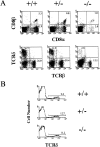The transcription factor interferon regulatory factor 1 (IRF-1) is important during the maturation of natural killer 1.1+ T cell receptor-alpha/beta+ (NK1+ T) cells, natural killer cells, and intestinal intraepithelial T cells
- PMID: 9500799
- PMCID: PMC2212195
- DOI: 10.1084/jem.187.6.967
The transcription factor interferon regulatory factor 1 (IRF-1) is important during the maturation of natural killer 1.1+ T cell receptor-alpha/beta+ (NK1+ T) cells, natural killer cells, and intestinal intraepithelial T cells
Abstract
In contrast to conventional T cells, natural killer (NK) 1.1+ T cell receptor (TCR)-alpha/beta+ (NK1+T) cells, NK cells, and intestinal intraepithelial lymphocytes (IELs) bearing CD8-alpha/alpha chains constitutively express the interleukin (IL)-2 receptor (R)beta/15Rbeta chain. Recent studies have indicated that IL-2Rbeta/15Rbeta chain is required for the development of these lymphocyte subsets, outlining the importance of IL-15. In this study, we investigated the development of these lymphocyte subsets in interferon regulatory factor 1-deficient (IRF-1-/-) mice. Surprisingly, all of these lymphocyte subsets were severely reduced in IRF-1-/- mice. Within CD8-alpha/alpha+ intestinal IEL subset, TCR-gamma/delta+ cells and TCR-alpha/beta+ cells were equally affected by IRF gene disruption. In contrast to intestinal TCR-gamma/delta+ cells, thymic TCR-gamma/delta+ cells developed normally in IRF-1-/- mice. Northern blot analysis further revealed that the induction of IL-15 messenger RNA was impaired in IRF-1-/- bone marrow cells, and the recovery of these lymphocyte subsets was observed when IRF-1-/- cells were cultured with IL-15 in vitro. These data indicate that IRF-1 regulates IL-15 gene expression, which may control the development of NK1+T cells, NK cells, and CD8-alpha/alpha+ IELs.
Figures





References
Publication types
MeSH terms
Substances
LinkOut - more resources
Full Text Sources
Other Literature Sources
Research Materials

